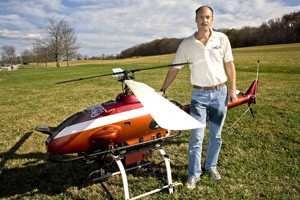The Aircraft Is Designed To Investigate Nuclear Disasters
Students at Virginia Tech’s Unmanned Systems Laboratory
are perfecting an autonomous helicopter they hope will never be
used for its intended purpose. Roughly six feet long and weighing
200 pounds, the re-engineered aircraft is designed to fly into
American cities blasted by a nuclear weapon or dirty bomb.

The helicopter’s main mission would be to assist military
investigators in the unthinkable: Enter an American city after a
nuclear attack in order to detect radiation levels, map and
photograph damage. “It’s for a worst-case
scenario,” said project leader Kevin Kochersberger
(above) , a research associate professor with the College of
Engineering and director of the Virginia Tech Unmanned Systems
Laboratory . His team consists of several graduate and
undergraduate students from the mechanical engineering (ME) and
electrical and computer engineering departments.
Kochersberger and his team re-engineered a remote-controlled
Yamaha-built Unmanned Aerial Vehicle RMAX helicopter to fly in
fully autonomous mode. They also created flight control software
algorithms that will direct the helicopter to radioactive sources
on its own accord. To carry out various missions, the researchers
outfitted the helicopter with various “plug-and-play
payloads” as the vehicle’s weight capacity is limited.
The payloads are easily loadable and unloadable boxes that fit
snugly under the helicopter’s main body, carrying devices
that would detect radiation levels in the atmosphere and on the
ground, and take video and still images of damage. Flight control
software would allow the mission to be changed mid-flight.
One payload is unique: A miniature tray-like robot on treads
that can be launched via a tether wire from the helicopter to
collect evidence. The helicopter would hover over the robot, and
pull it back via the wire. A student team is building this robot,
which will boast not only “chunk” sampling capability,
but also a miniature vacuum which could suck up dust and dirt.
The robot is expected to easily maneuver any terrain, including
expected bomb craters, as part of its investigation, said Michael
Rose, an ME graduate student, from Gilroy, CA. The team plans to
make the robot water proof, in the event that it comes across water
– busted water mains, lakes, rain puddles, etc. “The
electronics must be protected from the harmful elements,”
Rose said.
The group also designed a downward-looking stereo camera system
mounted to the helicopter, to image affected areas. The cameras
would allow for computerized 3-D terrain mapping of affected areas,
an absolute necessity to understand the characteristics of the
blast. It is expected that the helicopter will have night vision
capabilities, and enhanced imaging technologies that improve vision
through smoke and fog as the project progresses, Kochersberger
said.
The project, already funded at $735,000 with an additional
$650,000 allocated for 2010, is overseen by the U.S. Defense Threat
Reduction Agency and spearheaded by the Department of
Energy’s Savannah River National Laboratory. Plans call for
the helicopters to be mission-ready in three years. Department of
Defense (DoD) personnel already have visited Blacksburg to watch a
demonstration as the craft zeroed in on a small, planted
radioactive source at Kentland Farm, several miles from the
Virginia Tech campus. More testing is underway, with another DoD
demonstration planned for 2010 in Savannah, GA.
 ANN's Daily Aero-Linx (06.29.25)
ANN's Daily Aero-Linx (06.29.25) ANN's Daily Aero-Term (06.29.25): Gross Navigation Error (GNE)
ANN's Daily Aero-Term (06.29.25): Gross Navigation Error (GNE) Classic Aero-TV: Anticipating Futurespace - Blue Origin Visits Airventure 2017
Classic Aero-TV: Anticipating Futurespace - Blue Origin Visits Airventure 2017 NTSB Final Report: Cirrus SR22
NTSB Final Report: Cirrus SR22 Airborne Affordable Flyers 06.26.25: PA18 Upgrades, Delta Force, Rhinebeck
Airborne Affordable Flyers 06.26.25: PA18 Upgrades, Delta Force, Rhinebeck



